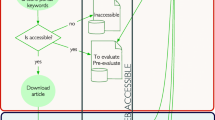Abstract
Internet literature queries return a long lists of citations, ordered according to their relevance or date. Query results may also be represented using Visual Language that takes as input a small set of semantically related concepts present in the citations. First experiments with such visualization have been done using PubMed neuronal plasticity citations with manually created semantic graphs. Here neurocognitive inspirations are used to create similar semantic graphs in an automated fashion. This way a long list of citations is changed to small semantic graphs that allow semi-automated query refinement and literature based discovery.
Preview
Unable to display preview. Download preview PDF.
Similar content being viewed by others
References
Duch, W., Matykiewicz, P., Pestian, J.: Neurolinguistic approach to natural language processing with applications to medical text analysis. Neural Networks (in press, 2008), doi:10.1016/j.neunet.2008.05.008
Buzan, T.: The Mind Map Book. Penguin Books (2000)
Farrand, P., Hussain, F., Hennessy, E.: The efficacy of the mind map study technique. Medical Education 36(5), 426–431 (2002)
Kraft, R., Zien, J.: Mining anchor text for query refinement. In: Proceedings of the 13th international conference on World Wide Web, pp. 666–674. ACM, New York (2004)
Gordon, M.D., Lindsay, R.K.: Toward discovery support systems: a replication, re-examination, and extension of swanson’s work on literature-based discovery of a connection between raynaud’s and fish oil. J. Am. Soc. Inf. Sci. 47(2), 116–128 (1996)
Zender, P.M., Crutcher, K.A.: Visualizing alzheimer’s disease research: a classroom collaboration of design and science. In: SIGGRAPH 2004: ACM SIGGRAPH 2004 Educators program, p. 24. ACM, New York (2004)
Zender, M., Crutcher, K.A.: Visual language for the expression of scientific concepts. Visible Language 41, 23–49 (2007)
Duch, W., Szymaski, J.: Semantic web: Asking the right questions. In: Gen, M., Zhao, X., Gao, J. (eds.) Series of Information and Management Sciences, California Polytechnic State University, CA, USA, pp. 456–463 (2008)
Pedrycz, W.: Knowledge-Based Clustering: From Data to Information Granules. Wiley Interscience, Hoboken (2005)
U.S. National Library of Medicine, National Institutes of Health: Unified medical language system (January 2007), http://www.nlm.nih.gov/research/umls/
Zender, M.: Advancing icon design for global non verbal communication: Or what does the word bow mean? Visible Language 40, 177–206 (2006)
McNamara, T.P.: Semantic Priming: Perspectives From Memory and Word Recognition. Psychology Press, Taylor & Francis Group (2005)
Duch, W., Matykiewicz, P., Pestian, J.: Towards Understanding of Natural Language: Neurocognitive Inspirations. In: de Sá, J.M., Alexandre, L.A., Duch, W., Mandic, D.P. (eds.) ICANN 2007. LNCS, vol. 4669, pp. 953–962. Springer, Heidelberg (2007)
Duch, W., Matykiewicz, P., Pestian, J.: Neurolinguistic approach to vector representation of medical concepts. In: Press, I. (ed.) Proc. of the 20th Int. Joint Conference on Neural Networks (IJCNN), August 2007, p. 1808 (2007)
Jurasinski, G.: simba: A Collection of functions for similarity calculation of binary data, R package version 0.2-5 (2007)
Legendre, P., Legendre, L.: Numerical Ecology. Elsevier, Amsterdam (1998)
Anderberg, M.R.: Cluster Analysis for Applications. Academic Press, New York (1973)
Milligan, G.W.: An examination of the effect of six types of error perturbation on fifteen clustering algorithms. Psychometrika 45, 325–342 (1980)
Walesiak, M., Dudek, A.: clusterSim: Searching for optimal clustering procedure for a data set, R package version 0.36-1 (2008)
Davies, D.L., Bouldin, D.W.: A cluster separation measure. IEEE Transactions on Pattern Analysis and Machine Intelligence 1, 224–227 (1979)
Calinski, R.B., Harabasz, J.: A dendrite method for cluster analysis. Communications in Statistics 3, 1–27 (1974)
Milligan, G.W., Cooper, M.C.: An examination of procedures of determining the number of cluster in a data set. Psychometrika 50, 159–179 (1985)
Kaufman, L., Rousseeuw, P.J.: Finding groups in data: an introduction to cluster analysis. Wiley, New York (1990)
Hotho, A., Staab, S., Stumme, G.: Wordnet improves text document clustering. In: Proc. of the Semantic Web Workshop at SIGIR-2003, 26th Annual International ACM SIGIR Conference (2003)
Sedding, J., Kazakov, D.: Wordnet-based text document clustering. In: Pallotta, V., Todirascu, A. (eds.) COLING 2004 3rd Workshop on Robust Methods in Analysis of Natural Language Data, Geneva, Switzerland, August 2004, pp. 104–113 (2004)
Struble, C.A., Dharmanolla, C.: Clustering mesh representations of biomedical literature. In: Lynette, H., James, P. (eds.) HLT-NAACL 2004 Workshop: BioLINK 2004, Linking Biological Literature, Ontologies and Databases, May 2004, pp. 41–48. Association for Computational Linguistics, Boston (2004)
Yoo, I., Hu, X., Song, I.-Y.: A coherent biomedical literature clustering and summarization approach through ontology-enriched graphical representations. In: Tjoa, A.M., Trujillo, J. (eds.) DaWaK 2006. LNCS, vol. 4081, pp. 374–383. Springer, Heidelberg (2006)
Jing, L., Zhou, L., Ng, M.K., Huang, J.Z.: Ontology-based distance measure for text clustering. In: Proceedings of the IV Workshop on Text Mining; VI SIAM International Conference on Data Mining (April 2006)
Kreher, D., Holocomb, P., Goff, D., Kuperberg, G.: Neural evidence for faster and further automatic spreading activation in schizophrenic thought disorder. Schizophrenia bulletin 34, 473–482 (2008)
Matykiewicz, P., Duch, W., Pestian, J.: Nonambiguous concept mapping in medical domain. In: Rutkowski, L., Tadeusiewicz, R., Zadeh, L.A., Żurada, J.M. (eds.) ICAISC 2006. LNCS (LNAI), vol. 4029, pp. 941–950. Springer, Heidelberg (2006)
Kohonen, T., Kaski, S., Lagus, K., Salojrvi, J., Paatero, V., Saarela, A.: Organization of a massive document collection. IEEE Transactions on Neural Networks 11(3), 574–585 (2000)
Author information
Authors and Affiliations
Editor information
Editors and Affiliations
Rights and permissions
Copyright information
© 2009 Springer-Verlag Berlin Heidelberg
About this paper
Cite this paper
Matykiewicz, P., Duch, W., Zender, P.M., Crutcher, K.A., Pestian, J.P. (2009). Neurocognitive Approach to Clustering of PubMed Query Results. In: Köppen, M., Kasabov, N., Coghill, G. (eds) Advances in Neuro-Information Processing. ICONIP 2008. Lecture Notes in Computer Science, vol 5507. Springer, Berlin, Heidelberg. https://doi.org/10.1007/978-3-642-03040-6_9
Download citation
DOI: https://doi.org/10.1007/978-3-642-03040-6_9
Publisher Name: Springer, Berlin, Heidelberg
Print ISBN: 978-3-642-03039-0
Online ISBN: 978-3-642-03040-6
eBook Packages: Computer ScienceComputer Science (R0)




